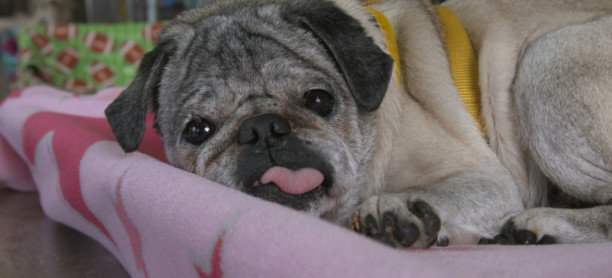5 Tips for Your Pug’s Heath and Happiness
Congratulations, you got yourself a new Pug friend for life! No doubt you’re excited, and learning more about the breed everyday. As you’re likely already aware, Pugs – like every dog breed – are unique in their personalities and needs, and you’ll want to take the time to familiarize yourself with the specific health needs of their breed. While every dog is different, even within the same breed, there are general need-to-knows for each breed of dog, especially those with short snouts! (Affectionate name = smooshy faces). We’ve rounded up five top care tips for new Pug owners.
1. Smoosh Face Problems
Pugs have very short snouts and it makes them sensitive to heat. They have a narrower windpipe, narrow nostrils and a long soft palate, which takes up room at the backs of their throats. This tissue vibrates whenever they take a breath, often making them noisy breathers and especially noisy snorers! From transporting them in vehicles to being out in the sun too long, just make sure you’re keeping them cool and well hydrated. Heat exposure can lead to heat stroke, which affects a Pugs heart and kidneys and can lead to seizures and strokes. Pay attention to their breathing and any changes in behavior, as well as their stool. Exertion will cause them to pant heavily, as their body works to gain oxygen. On especially warm days, keep exercise inside-based and only go outside for short walks. Learn to recognize the signs of distress, including blue gums or tongue, thick sticky saliva and/or a reluctance to move. No need to overthink this or turn them into a vampire, just be careful on days that climb into the 80 degrees Fahrenheit and above!
2. A Fit Pug is a Happy Pug
Exercise your Pug! Some people assume that if you have a small dog, they don’t need the kind of exercise that a larger breed may need. And while it’s true that your Pug might not want to run laps around the block with you (save that for the Labs!), they do need exercise in the same way all animals do. While they’ll be used to sleeping 14 hours a day on average, make sure to get them outside for a walk a few times a day. It doesn’t even have to be long – and you’ll often be able to tell where they’re at with their limits by paying attention to their breathing. Younger, healthy Pugs will also love a trip to the dog park to play with other dogs and get their energy out in a social and fun setting. No matter the activity, even thirty minutes a day is better than nothing at all.

3. Pug Teeth
Care for their teeth. Dogs with healthier teeth digest their food better, reducing the chances of intestinal blockages and stomach related illnesses. While it can feel like an awfully big pain, it’s important to brush your dog’s teeth as often as possible (once a week is already ahead of the curve!) Your vet will have some tips on how best to do this, but it’s helpful to get a liver flavored toothpaste, wrap your Pug in a towel and have someone help hold them while you brush away. Do your homework to see which products are good with dogs teeth and match that up with treats your dog actually seems to enjoy chewing on!
4. Don’t Bug Your Pug
Use flea and tick prevention. Not only do these measures help protect your pup from fleas and ticks themselves, they also work to combat worms. Your vet should be able to help you acquire the best repellents, such as Frontline, that you can administer monthly to your dog. No matter where you live, ticks can be found, even in city life! Clean up eliminations immediately after they’re done, as worms like Hookworms can be found in stool and their eggs can lay dormant in the grass for a long time. If you do notice fleas or ticks on your dog or worms in their stool, consult with your vet immediately for the best course of action. When caught quickly, there are simple courses of action to help out. But it’s great if you can prevent them from happening in the first place!

5. Choose an awesome food.
Pugs are muscular, solid dogs with rounded features. (We recommend DOG for DOG’s DOGSFOOD, a Save Our Shelter partner, with a mission to feed healthy food to your dog, and dogs in need!) Healthy food will deter carrying extra weight, which is harder when you’re smaller, as it puts extra demands on the body for oxygen, compressing the lungs, airway and throat. Your little dude doesn’t need anything else impeding his breathing!
And there you have it! Five tips for helping your new furry friend live a comfortable and happy existence in your home and wherever your adventures take you. Have some tips of your own to share with fellow Pug owners? Dispense them in the comments below, and together we can establish the perfect Pug-guide-to-life!





 Five Reasons Why Donating Dog Food to a Shelter Makes a Difference
Five Reasons Why Donating Dog Food to a Shelter Makes a Difference Five Reasons Why Donating Dog Food to a Shelter Makes a Difference
Five Reasons Why Donating Dog Food to a Shelter Makes a Difference Adopting 101: Size, Breed, and Energy Levels
Adopting 101: Size, Breed, and Energy Levels 6 Tips for Adopting the Right Match
6 Tips for Adopting the Right Match Save Our Shelter with Cathy Bissell
Save Our Shelter with Cathy Bissell




